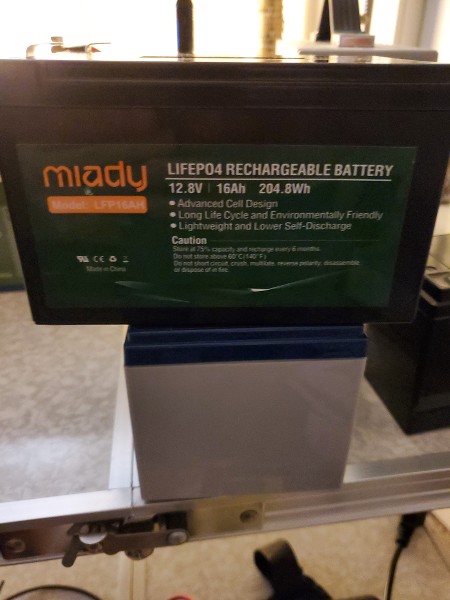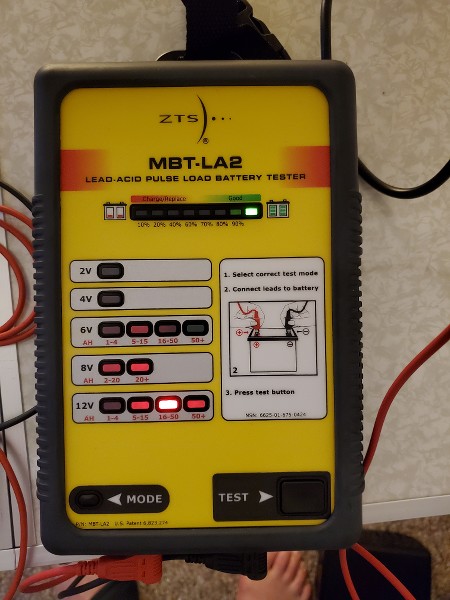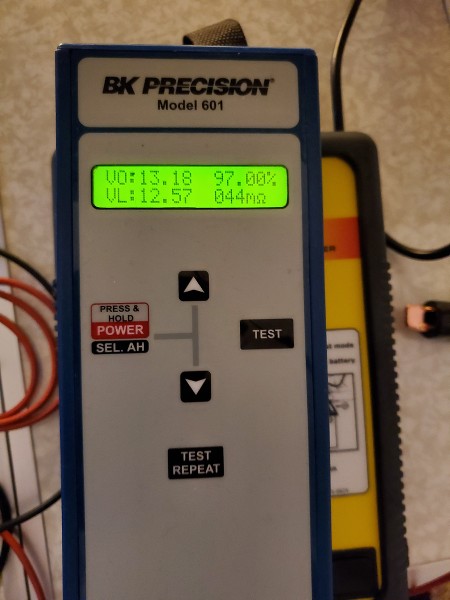Originally posted by Turion
View Post
Announcement
Collapse
No announcement yet.
The bistander thread
Collapse
X
-
-
Altrez,
There is a very SIMPLE test you can do to prove what I have been saying. Not sure if I brought this up before, but I might have. I talked to a lot of different people, including by email, so I am always running off at the mouth. Anyway, this is the test, and it requires NO special motor to get results, although a pulse motor will make the results more obvious.
Charge your battery, let it rest, and use your battery analyzer to measure it and record your results.
Now, connect a simple boost module to the battery and set the output to 14 volts. Run your motor at a constant (measured) RPM for a set amount of time...say 30 minutes connected directly to the positive and negative output of the boost module. When finished, let the battery rest and measure your results after the battery has recovered.
Recharge the battery and let it rest.
Set the output of the boost module to around 26 volts. Connect the positive out of the boost module to one side of the motor, and the other side of the motor to the positive of the battery. You may need to increase the output of the boost module to get it to run the motor at the same RPM as it ran directly off the boost module rather than between the positives as it is running NOW. If necessary, make the voltage adjustment to get the same RPM. Run the motor for the SAME amount of time at the SAME RPM. Then let the battery rest for the SAME amount of time and measure the battery.
Simple test. No one should be able to argue with the results. But they will.“Advances are made by answering questions. Discoveries are made by questioning answers.”
—Bernhard Haisch, Astrophysicist
Comment
-
Turion,Originally posted by Turion View PostAltrez,
There is a very SIMPLE test you can do to prove what I have been saying. Not sure if I brought this up before, but I might have. I talked to a lot of different people, including by email, so I am always running off at the mouth. Anyway, this is the test, and it requires NO special motor to get results, although a pulse motor will make the results more obvious.
Charge your battery, let it rest, and use your battery analyzer to measure it and record your results.
Now, connect a simple boost module to the battery and set the output to 14 volts. Run your motor at a constant (measured) RPM for a set amount of time...say 30 minutes connected directly to the positive and negative output of the boost module. When finished, let the battery rest and measure your results after the battery has recovered.
Recharge the battery and let it rest.
Set the output of the boost module to around 26 volts. Connect the positive out of the boost module to one side of the motor, and the other side of the motor to the positive of the battery. You may need to increase the output of the boost module to get it to run the motor at the same RPM as it ran directly off the boost module rather than between the positives as it is running NOW. If necessary, make the voltage adjustment to get the same RPM. Run the motor for the SAME amount of time at the SAME RPM. Then let the battery rest for the SAME amount of time and measure the battery.
Simple test. No one should be able to argue with the results. But they will.
have you run this test?
bi
Comment
-
-
Hello All,
I picked up these boost modules to test out.
https://smile.amazon.com/gp/product/...?ie=UTF8&psc=1
-Altrez
Comment
-
Turion,Originally posted by Turion View PostAltrez,
There is a very SIMPLE test you can do to prove what I have been saying. Not sure if I brought this up before, but I might have. I talked to a lot of different people, including by email, so I am always running off at the mouth. Anyway, this is the test, and it requires NO special motor to get results, although a pulse motor will make the results more obvious.
Charge your battery, let it rest, and use your battery analyzer to measure it and record your results.
Now, connect a simple boost module to the battery and set the output to 14 volts. Run your motor at a constant (measured) RPM for a set amount of time...say 30 minutes connected directly to the positive and negative output of the boost module. When finished, let the battery rest and measure your results after the battery has recovered.
Recharge the battery and let it rest.
Set the output of the boost module to around 26 volts. Connect the positive out of the boost module to one side of the motor, and the other side of the motor to the positive of the battery. You may need to increase the output of the boost module to get it to run the motor at the same RPM as it ran directly off the boost module rather than between the positives as it is running NOW. If necessary, make the voltage adjustment to get the same RPM. Run the motor for the SAME amount of time at the SAME RPM. Then let the battery rest for the SAME amount of time and measure the battery.
Simple test. No one should be able to argue with the results. But they will.
I have a few of the Razor motors in stock. I was curious can it be any load? If so I was going to use my load tester for really dialing in the load.
Thanks for the help!
-Altrez
Comment
-
Hi Turion,Originally posted by Turion View Postaltrez,
I purchased ONE Lithium IronPhosphate battery, and ended up taking it apart because the BMS wouldn't allow me to do what I wanted to do. Since that time I have only purchased cells and put my own battery together. These are the BMS chips I am using with the cells.
https://www.amazon.com/gp/product/B0...?ie=UTF8&psc=1
I thought something was odd about your post when I first read it and viewed the "BMS chips" link. That's why I inquired about how you connected them perviously only to get insulted in a childish manner by you. So I contacted the seller from the Amazon link. In a reply this is what was stated:
"This product cannot be used in series, but can be used in parallel. If you want to use 3 batteries in series, you must use a 3S protection board. The link is as follows:"
Although you didn't specify, your post inferred that you acquired individual cells and assembled them into a multiple cell battery using the linked chips as BMS. Furthermore, since the LiFePO4 battery you disassembled a while ago, when I helped you identify the cells, was a 12V battery with 4S (4 cells in series), it's reasonable to think you are now talking about building a 4S, 12V battery. The product in your link is a 1S PCB, Protection Circuit Board for 1 Series cell. You call it a BMS. There is often confusion between PCB, BMS & PCM. Read more:
"Li-ion, Li-Poly and LiFePO4 battery packs should be used with a protection circuit to prevent the cell from over charging or over dis-charging. Choosing the correct circuit and applying it appropriately is vital to the longevity your batteries and your own safety.
For high drain Lithium batteries, protection chip board is not a necessary for protecting the battery from over-charged if a good quality balance charger is being used on charging the battery. But it still needs attention not to over-discharged the battery without using the protection ship board.
High drain and high voltage LiFePO4 & Lithium battery packs with a battery BMS (battery management system) could avoid over-charged / over discharged, and also get balance monitoring from the system, with the balancing management, it will greatly keep good consistence and extend battery life, safe and secure the high discharge current enviorment.
The protection chip board can not be used on replacing batteries for digital camera, laptop or power tools. The electronic devices like digital camera, Laptop or power tool will only work with original chip boards."
From: http://www.batterysupports.com/batte...-pcm-c-32.html
I am just trying to help you and members/readers who are not familiar with Lithium cells/batteries and associated parts and procedures. Lithium batteries are great. They or some other "advanced" cells will undoubtedly eventually obsolete Pb-Acid cells. But the Lithium cell is more sensitive to damage from abuse than Pb-Acid. It is quite easy to ruin a cell from overcharge or overdischarge or overheat. And they tend to be costly, and sometimes prone to combustion. So learn how to use them safely.
I have years of experience in building, testing and using Lithium batteries. But don't take my word. Research the subject for yourself. And be careful who you do take advise from.
Regards,
bi
Comment
-
Any 12 volt load should work.
bi,
You are correct about the link. I sent the wrong one. But I am not using the cells the way you indicated. I actually built a 22.4 volt battery. The reason being, a 24 volt inverter will still operate on less than 24 volts, and if my return to the battery is 24 volts, then that is a couple volts over the "standing voltage" of a 22.4V battery so it keeps it in a charge state. I don't have time to work on that project right now though. Still busy on my house. Getting close though. See, when you are right, and seek to help, I am willing to acknowledge it and respond accordingly. So much so that I won't even mention you know what.“Advances are made by answering questions. Discoveries are made by questioning answers.”
—Bernhard Haisch, Astrophysicist
Comment
-
Turion,Originally posted by Turion View PostAny 12 volt load should work.
bi,
You are correct about the link. I sent the wrong one. But I am not using the cells the way you indicated. I actually built a 22.4 volt battery. The reason being, a 24 volt inverter will still operate on less than 24 volts, and if my return to the battery is 24 volts, then that is a couple volts over the "standing voltage" of a 22.4V battery so it keeps it in a charge state. I don't have time to work on that project right now though. Still busy on my house. Getting close though. See, when you are right, and seek to help, I am willing to acknowledge it and respond accordingly. So much so that I won't even mention you know what.
All I ever did was to try to help and try to learn something.
So what cells and protection/management scheme are you using?
Regards,
bi
Comment
-




Comment